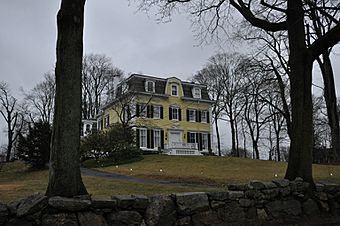Strickland Road Historic District facts for kids
Quick facts for kids |
|
|
Strickland Road Historic District
|
|
 |
|
| Location | 19-47 Strickland Rd., Cos Cob, Connecticut |
|---|---|
| Area | 9 acres (3.6 ha) |
| Architectural style | Late 19th and 20th Century Revivals, Late Victorian, Colonial |
| NRHP reference No. | 77001625 |
| Added to NRHP | March 22, 1990 |
The Strickland Road Historic District is a special area in Greenwich, Connecticut. It's like a time capsule, showing how homes looked over 200 years! This historic district covers about 9 acres. It was added to the U.S. National Register of Historic Places in 1990.
You can find this district along Strickland Road in the Cos Cob part of Greenwich. It stretches from River Road in the south to just north of Loughlin Road. The district has many old houses, built between 1740 and 1934. These homes show different styles of building from those times.
One very important house here is the Bush–Holley House. It was built around 1730. Today, it's a historic house museum. This house is also a National Historic Landmark because it was a key place for the Cos Cob art colony. In total, there are 28 main buildings that help make this district historic. Most of these buildings are made of wood and are one to three stories tall. A few newer homes are different, built with brick and stucco in the Tudor Revival style.
A Glimpse into Cos Cob's Past
The Cos Cob area was settled a long time ago, in the 1600s. First, Dutch settlers came, and then English settlers arrived. It started as a community by the water, important for boats and trade.
Strickland Road: A Busy Hub
The area around Strickland Road was known as the Lower Landing. It became very busy in the 1700s. David Bush, who built the Bush-Holley House, helped it grow. This spot was a major transportation center. Small boats called "packet boats" would carry goods and people to other nearby ports. Some of the fancier houses on Strickland Road were built by sea captains.
Changes Over Time
In the mid-1800s, things changed. Trains became popular, and they took over from packet boats. This made the Lower Landing less important for transportation. The area then became mostly a place where people lived. The last big industrial building, a mill that used the ocean's tides to grind grain, burned down in 1899. Many of the homes you see in the district today were built in the early 1900s. They show popular styles from that time, like Bungalow and Tudor Revival.



